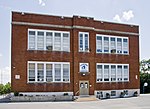Harmony Cemetery (Marlowe, West Virginia)
1830 establishments in VirginiaCemeteries on the National Register of Historic Places in West VirginiaNational Register of Historic Places in Berkeley County, West Virginia

Harmony Cemetery is a historic cemetery located near Marlowe, Berkeley County, West Virginia. It is an interdenominational burial ground established about 1830. It includes a number of notable grave markers and is the site of the old Harmony Meeting House.It was listed on the National Register of Historic Places in 1991.
Excerpt from the Wikipedia article Harmony Cemetery (Marlowe, West Virginia) (License: CC BY-SA 3.0, Authors, Images).Harmony Cemetery (Marlowe, West Virginia)
Nestle Quarry Road,
Geographical coordinates (GPS) Address External links Nearby Places Show on map
Geographical coordinates (GPS)
| Latitude | Longitude |
|---|---|
| N 39.586944444444 ° | E -77.881666666667 ° |
Address
Harmony Cemetery
Nestle Quarry Road
25419
West Virginia, United States
Open on Google Maps






